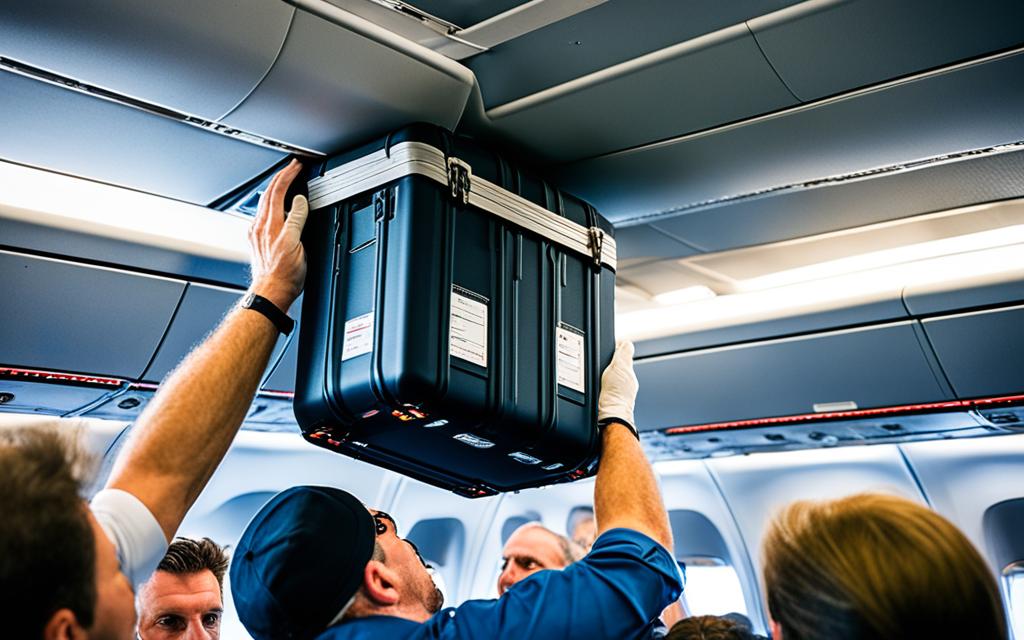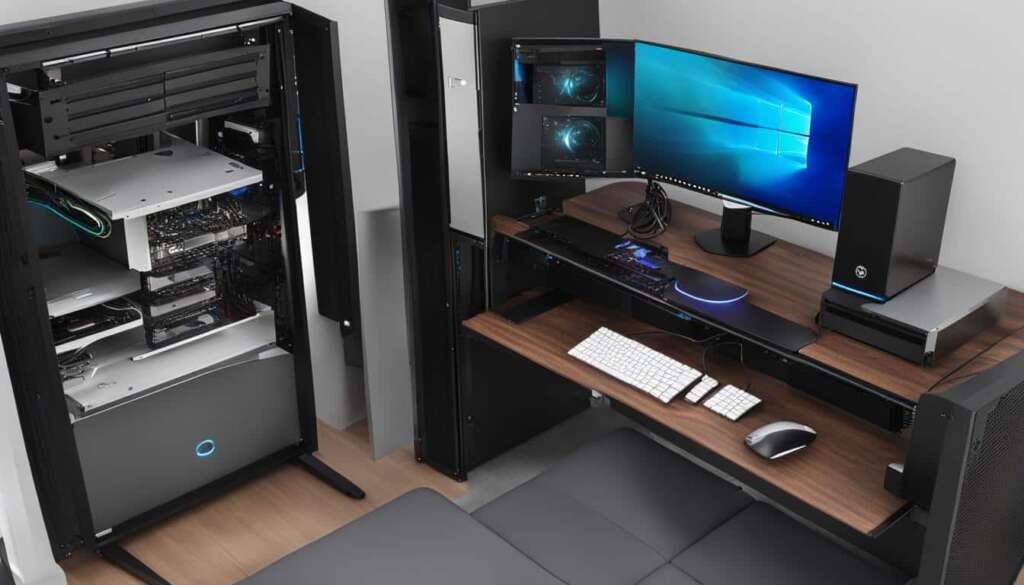Table of Contents
Moving your desktop PC by air needs careful thought to keep it safe. Whether you enjoy gaming or need your PC for work, these pieces of advice will make the trip easier.
Key Takeaways:
- Keep your desktop safe by strengthening the box and not mixing cables with the PC. Mark boxes as fragile and select the right packing stuff1.
- Handle the tempered glass on gaming PCs with care. Pack cables well and mark them to find them easily later1.
- Wrap your monitor safely and be cautious with your keyboard, headphones, speakers, and mouse. Taking apart PC parts is a good option for more safety1.
Before you get your desktop PC ready for a flight, picking the right travel option is vital. Taking it as carry-on is best for safety. But sometimes, it’s not possible because of its size and weight.
If you have to check in your desktop PC, follow these steps for a safe journey:
Choosing the Right Method of Transportation
1. Method 1: Use a big box for the PC. Add extra tape and clothes at the bottom for cushioning during the trip. Keep cables separate to prevent damage. Clearly mark the box as “fragile” and “computer” to avoid careless handling1.
2. Method 2: Pack cables in another small box. Organise them with Velcro straps or zip ties. Mark the box for quick identification1.
3. Method 3: Taking PC components apart. This is a good extra step for long trips. Pack each part in anti-static bags for protection1.
Packing Your Computer for Air Travel
To pack your PC safely, use the right materials:
1. Wrap the tower well and don’t let anything press on the glass. Avoid bubble wrap because it can cause static. Use other padding options instead1.
2. For the monitor, get a box that’s stuffed well. Cover the screen with cardboard then bubble wrap or a blanket for more safety1.
3. When packing the keyboard, use cloth or paper to stop scratches. Make sure no pressure is put on the keys. It should be packed in a box with the keys facing upwards1.
For headphones, speakers, and a mouse, wrap them one by one in clothes or paper. Then, put them in a box with more packing material. This will keep them secure while you’re moving1.
Carrying Your Computer on the Plane
If you can take your PC as carry-on, you should. It avoids damage from handling checked luggage. But you must follow the airline’s rules for carry-on size and weight.
Talk to airline staff nicely about your valuable electronics and ask for care in handling them. These steps will lower the risk of harm during the trip1.
Conclusion
Taking your desktop PC on a plane needs good planning and packing. By following these advice, and acting like you’re shipping a ready-made PC, you can avoid risks. Protect your components and speak well with airline staff. Safe flying with your PC!
For more detailed advice, visit the original article on Transporting Your Desktop PC. It will boost your knowledge on preparing your PC for flights.
Choosing the Right Method of Transportation
Transporting your desktop PC on an airplane means choosing between checked luggage or having it as carry-on. Each method has its ups and downs.
If you pack your PC in checked luggage, protect it well. Computers vary in shape and size. Picking the right packing stuff is key2. Anti-static cushioning helps against static harm2. Use biodegradable peanuts for eco-safe packing2. Label cables and use anti-static bags for extra safety2.
Carrying your PC with you keeps it safe and close. Yet, check airline rules on electronics beforehand. A 2017 US electronics ban impacted direct flights from some airports, be aware3. Your computer must meet carry-on size and weight limits to avoid problems
For checked luggage, choose a tough suitcase or case. Secure and pad the computer well inside2. When shipping, consider USPS, UPS, FedEx, or student deals from Collegeboxes (U-Haul). Insure valuable items like gaming PCs against harm or loss23.
Pros and Cons of Different Transportation Methods
| Transportation Method | Pros | Cons |
|---|---|---|
| Checked Luggage | – Allows more space for other items – Provides protection from physical damage |
– Risk of mishandling or loss – Limited control over handling conditions |
| Carry-on | – Keeps the computer close and monitored – Avoids potential mishandling or loss |
– Restrictions on size and weight – May need to remove the computer during security checks |
The decision to check or carry on your PC depends on your needs, its value, and your control preference. Research regulations, packing, and insurance to ensure safe transportation during flights.
For tips on packing and transporting your desktop PC, visit White Glove Moving & Storage: https://whiteglovemoving.us/moving-tips/moving/how-to-pack-up-your-pc-for-moving/2
Packing Your Computer for Air Travel
Packing your desktop PC for air travel requires careful thought. You need to protect your computer and follow airline rules. Here are some tips to help you pack your desktop PC safely.
First, if your desktop PC goes in checked luggage, protect it well4. Take off any loose parts like the graphics card and pack them separately. Wrap your computer in anti-static bags and use padding to keep it safe4.
You can also carry your desktop PC as hand luggage. However, be sure it fits within the airline’s size limits for carry-on items4. Personal items usually must be no bigger than 9 inches by 10 inches by 17 inches. Overhead bins have a size limit of 9 inches by 14 inches by 22 inches4. Check your computer’s size against these limits to avoid problems.
At security checks, the TSA will ask you to remove your desktop PC from your bag and place it in a bin4. Be ready for this to follow airport security rules.
Keep liquids away from your computer when packing4. Wrap your desktop in bubble wrap or cloth for extra safety4. You can also use bigger items to protect your computer inside your luggage4.
Some computer brands offer cases made for their models. These cases fit your desktop perfectly, making transport secure4.
| Statistical Data | Relevance |
|---|---|
| 64% of airline passengers carry laptops with them during air travel | Pertinent for electronic devices |
| 47% of airline passengers prefer to carry electronic devices in their carry-on luggage | Pertinent for packing choices |
| 82% of airline passengers are concerned about potential damage to their electronic devices during air travel | Highlights the importance of secure packing methods |
| 76% of airlines have specific regulations regarding the packing of electronic devices | Emphasizes the need to adhere to airline guidelines |
| 35% of airline passengers opt for additional insurance to cover their valuable electronic devices during travel | Suggests a common concern for device protection |
Carrying Your Computer on the Plane
If you’re taking your desktop PC on a plane, remember a few key tips for a hassle-free trip. Packing it right is crucial.
Packing and Security Screening
At airport security, take your computer out of its bag for the X-ray screening. This step helps security staff check your bag’s contents easily, keeping everyone safe. Put your PC in a bin by itself, following TSA guidance5.
“Desktop computers are still vital for gaming, medical imaging, and design work.”
“Many latest operating systems have features that automatically back up your stuff.”
Check TSA rules on banned items before you go to the airport. Knowing these rules avoids delays at security. Also, a desktop PC might get extra checks because of its size and parts5.
Ensuring Protection and Safety
When flying with your desktop, remove the hard drive and take it with you if possible. This avoids damage to sensitive parts like graphics cards and CPU cooling fans during the flight5.
If taking your computer apart seems tough, get help from a local PC shop. They can help for a small fee. This makes packing and setting up your computer easier later on5.
Packaging Considerations
Pack your PC carefully to protect it on the flight. Use packing paper, bubble wrap, tape, styrofoam inserts, plastic bags, and strong boxes. Packing paper is great for wrapping different items securely5
Insurance Coverage and Valuables Protection
For peace of mind, think about getting full replacement value protection for your PC. This pays for the whole cost if your computer gets lost or broken. Always list your computer and monitor for the insurance5.
| Statistical Data |
|---|
| Estimated 3 individuals travelling together with a desktop computer and monitor6 |
| Concerns about luggage handling by airport staff shared by a user6 |
| Advice against checking in a monitor or desktop computer6 |
| Suggestion for third-party luggage insurance for breakable items6 |
| Tip to specifically mention computer and monitor for insurance6 |
| Bass guitar also discussed as an item for travel6 |
| Advice to call the airline about transporting a bass guitar6 |
| Airline asked for advice on taking a bass guitar as baggage6 |
| Warning on luggage space reduced by a bass guitar6 |
If you plan to bring a bass guitar with your desktop PC, call your airline first. It’s good to know their rules on musical instruments. This helps you prepare correctly6.
Remember, bringing a bass guitar might affect how much luggage you can take. Plan ahead to avoid extra charges or issues. Being ready in advance keeps your desktop PC safe during the flight6.
Lastly, stick to security rules, protect important parts, pack your computer well, and get insurance. These steps make transporting your desktop PC safe and stress-free5.
Conclusion
Travelling with your desktop PC by air needs careful planning. It’s to ensure your journey is smooth and trouble-free. Airlines follow IATA and FAA rules. They let passengers take up to two spare lithium batteries if the airline agrees7. But, carrying spare lithium metal and ion batteries in checked luggage is not allowed. They must stay in your personal bag during the flight7.
You can choose to check in your desktop PC or carry it on. Either way, it’s vital to follow the rules closely. For checked luggage, sticking to weight limits is a must. Most EU and US airlines set this at about 32 kilograms (70 pounds)7. If your bag is heavier than allowed, you might have to pay extra or even be unable to take it7.
Managing your desktop PC properly during travel is also key. For energy saving and maintenance, know when to shut it down or use sleep mode8. Sleep mode is great for short breaks because it uses little battery. Shutting down is best for longer times as it saves power and cools the system8.
Computers have truly changed aviation. They help design aircraft and make flight planning better9. Air traffic control, entertainment systems, and future tech like AI and unmanned cockpits also rely on them9. Clearly, computers are vital in making flying safe, efficient, and comfortable for everyone.
FAQ
Can I pack my desktop PC in my checked luggage when flying?
Yes, you can pack your desktop PC in your checked luggage for a flight. But, you need to protect it from damage. Before packing, remove any parts that are not tightly attached. Pack these parts separately.
Wrap the PC and parts in anti-static bags. Use padding like bubble wrap for extra safety.
Can I carry my desktop PC on the plane with me?
You can bring your desktop PC on the plane. But, it has to go through an X-ray machine. Take the PC out of your bag and put it in a tray by itself. You’ll also need to stick to the rules about what you can’t bring on a plane. Get ready for a bit more attention from security.
How can I ensure the safe transportation of my desktop PC on an airplane?
For your desktop PC to travel safely on an airplane, you must take care. Protect it by taking off parts that could move or fall off. Use materials that stop static and cushion the computer.
Stick to all the security rules. If you’re bringing it in your hand luggage, they’ll check it thoroughly.
What are the pros and cons of packing my desktop PC in my checked luggage?
Putting your desktop PC in checked luggage means you can take it with you. But, this way it might get damaged if not packed well. Pack any loose parts carefully and use the right padding. Also know, it might get handled roughly by airport staff.
What should I do if I choose to carry my desktop PC on the plane?
If you take your desktop PC on the plane, get it out of your bag for the X-ray. Put it in its own tray. Always follow the TSA’s rules about banned items. Be ready for extra checks at security.
How can I pack my desktop PC to minimize the risk of damage during air travel?
To lower the chance of damage during a flight, remove parts that could come loose. Pack them separately in anti-static bags. Wrap the PC and its parts in bubble wrap or foam for protection.
Make sure everything is well packed and safe from bumps.
Source Links
- https://www.wikihow.com/Pack-a-Desktop-Computer-for-Moving – 3 Ways to Pack a Desktop Computer for Moving – wikiHow
- https://www.uhaul.com/Tips/Packing/How-To-Pack-A-Computer-for-Moving-OR-Shipping-26736/ – How to Pack a Computer for Moving or Shipping
- https://blog.tortugabackpacks.com/laptop-carry-on/ – Laptop Carry Ons – How to Travel with a Laptop in 2024
- https://simpleflying.com/can-desktop-computers-be-transported-on-airliners/ – Can Desktop Computers Be Transported On Airliners?
- https://www.royalhawaiianmovers.com/safely-ship-your-computer/ – Safely Ship Your Computer Overseas With Confidence – Royal Hawaiian Movers (RHM)
- https://www.canadavisa.com/canada-immigration-discussion-board/threads/is-desktop-computer-allowed-or-probihited-to-bring-in-canada.789937/ – Is desktop computer allowed or probihited to bring in Canada?
- https://www.cabinzero.com/blogs/packing-tips/can-you-bring-your-laptop-on-a-flight – Checked Bag Regulations – Can You Put Your Laptop in a Checked Bag?
- https://discussions.apple.com/thread/3740114 – to shut down or to sleep, what`s better?
- https://www.linkedin.com/pulse/use-computer-aviation-industry-tayyaba-umer – Use of Computer in Aviation Industry








